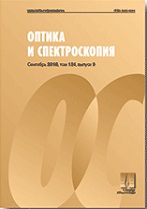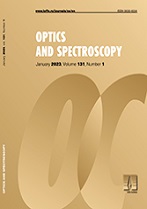|
This article is cited in 1 scientific paper (total in 1 paper)
Spectroscopy of condensed matter
Spectroscopic and quantum-chemical studies of halogen-containing derivatives of poly-N-epoxypropylcarbazole
E. V. Seliverstova, N. Kh. Ibrayev, A. K. Nurmakhanova, D. A. Temirbayeva
Institute of Molecular Nanophotonics, Buketov Karaganda State University, 100028, Karaganda, Kazakhstan
Abstract:
The results of a study of the optical properties of conducting polymers, namely, derivatives of poly-N-epoxypropylcarbazole (PEPC) with heavy atoms, are presented. It is shown that a heavy atom in the structure of a polymer molecule leads to bathochromic shifts in the absorption, fluorescence, and phosphorescence spectra. This is a consequence of a decrease in the energy of the electron levels due to a change in the electron density distribution over the $\pi$-electron system in the chromophores of 2IPEPC and 3BrPEPC. Two bands can be distinguished in the fluorescence spectra of PEPC with heavy atoms, just as in the parent polymer. The emission band with a maximum at 380 nm belongs to the monomer luminescent centers and the long-wavelength emission with a maximum at about 420 nm to the polymer excimers. A heavy atom changes the ratio of the intensities of the monomer and excimer bands. The fluorescence lifetimes also decrease in the presence of a heavy atom. Quantum-chemical estimation of the intramolecular transition constants has shown that the probability of the singlet–triplet intercombination conversion in the halogen-containing PEPCs is higher in PEPC. This leads to a markedly stronger phosphorescence of the iodine and bromine-containing polymers and a shorter luminescence lifetime. The obtained results can be used in the development of composite materials based on photoconductive polymers for photovoltaics and optoelectronics.
Received: 16.03.2018
Citation:
E. V. Seliverstova, N. Kh. Ibrayev, A. K. Nurmakhanova, D. A. Temirbayeva, “Spectroscopic and quantum-chemical studies of halogen-containing derivatives of poly-N-epoxypropylcarbazole”, Optics and Spectroscopy, 125:4 (2018), 479–484; Optics and Spectroscopy, 125:4 (2018), 499–505
Linking options:
https://www.mathnet.ru/eng/os881 https://www.mathnet.ru/eng/os/v125/i4/p479
|


|





 Contact us:
Contact us: Terms of Use
Terms of Use
 Registration to the website
Registration to the website Logotypes
Logotypes








 Citation in format
Citation in format 
